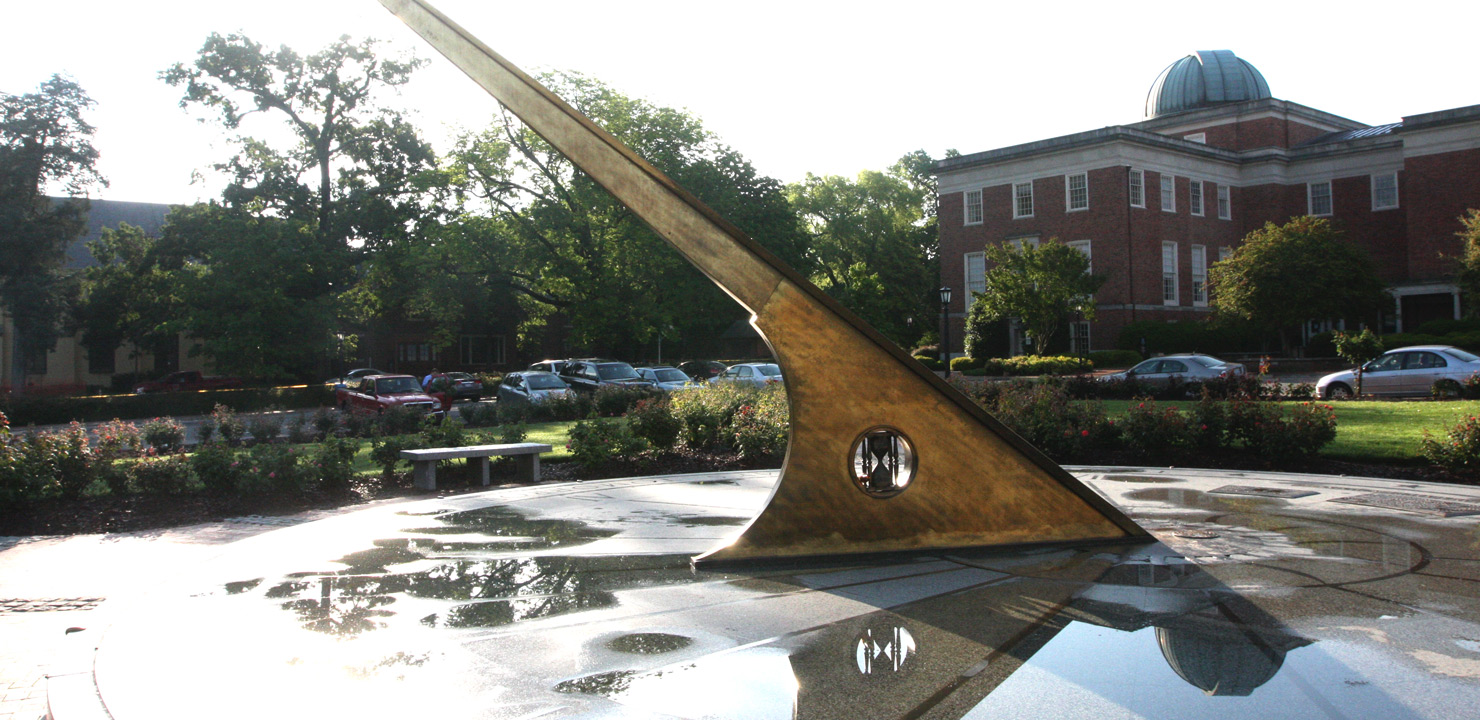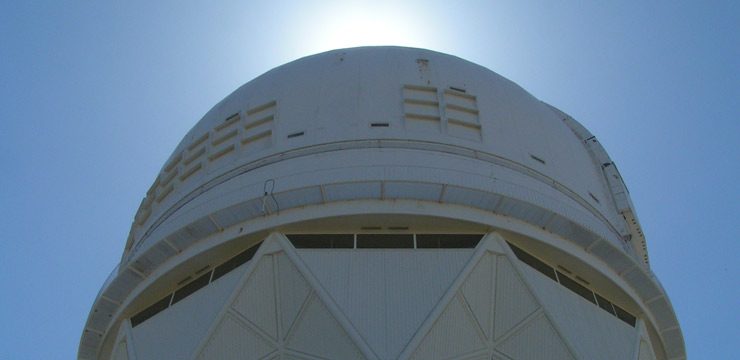
A Visit to Morehead Planetarium
June 2013 :
It is natural for us to give credit to astronauts for knowing much more about the sky than us amateurs. After all, we're not guiding our spacecraft with precision while flying through space at eight kilometers per second, but rather pointing our simple telescopes at our favorite planets and seasonal objects or showing others how to use the Big Dipper to find the North Star. But the fact of the matter is, those astronauts had to learn the same sky we did, and given the time constraints of the Space Race and all the other aspects of astronaut training they had to attend to, the men of the Mercury, Gemini, and Apollo programs didn't have the luxury of meeting with their local astronomical society once per week in the hopes of clear enough skies for at least a year to adequately learn their way around, not to mention that a good portion of the sky simply isn't visible from a fixed point on Earth.
What was needed was a planetarium. A high-tech piece of science wizardry that could simulate the sky in any direction at any time of year regardless of weather. Between 1959 and 1975, NASA astronauts were trained in the art of celestial navigation at the Morehead Planetarium on the campus of the University of North Carolina Chapel Hill.
Many of us have had fond memories of visiting planetariums when we were younger, on school field trips or on summer vacation. Some of us still aspire to travel far and wide to visit notable observatories and planetariums around the country. In recent years I have had the pleasure of visiting the Hayden Planetarium in New York, Adler in Chicago (including the original Atwood Sphere), and Griffith in Los Angeles. This is in addition to the numerous visits to the Charles Hayden in Boston over the years, and locally the Cormack Planetarium (named after one of Skyscrapers ten original Incorporators Maribelle Cormack), the planetarium at URI, and the home-built planetarium that was set up at Ladd Observatory a few years back, the projector for which Skyscrapers used for its 1975 Midland Mall portable planetarium.
Located just over a mile from Newfangled company headquarters in Chapel Hill, North Carolina, Morehead Planetarium has been on my short list of places to visit for several years. In 2010 I asked our local planetarian Francine Jackson if she knew a point of contact at Morehead and she connected me with Richard McColman, Fulldome Theater Director at the planetarium. While I always consider my trips to North Carolina to be business as well as pleasure, I hadn't been able to find the time during these busy week-long trips to pay the visit.
I would finally get that chance in the days before our annual spring retreat at the beginning of May 2013. I contacted Richard to let him know my travel schedule and availability and we worked out an appointment on Tuesday morning, May 7.
Upon arriving at the planetarium the most prominent feature you will notice is the very large sundial in the courtyard to the north of the building. A native Rhode Islander will notice the difference in latitude of the gnomon, which points the north celestial pole. Chapel Hill is about six degrees farther south than North Scituate. It was still mostly cloudy from overnight rain so I wasn't able to get a good read on the sundial.
When I approached the building, Richard was waiting to greet me, and after introductions he ushered me into the planetarium through a service entrance. Upon entering the dome I was impressed not only by its size, but also how sparse it appeared. This was the first time I had been inside a planetarium dome that did not have a large projection system in the center. I had known before my visit that the Zeiss Model VI projection system had been removed, but what I didn't realize was that the new fulldome projection system was so cleverly concealed in the perimeter of the dome.
Richard give me a brief history of the planetarium, which opened in 1949 and originally utilized a Zeiss Model II star projector. He talked about the 2011 replacement of the Zeiss Model VI star projector and efforts to preserve parts of it (unfortunately a new home could not be found and the planetarium does not have the space to preserve it in complete form) and also talked about planned renovations to the building
When we began talking about the projection system he showed me to a nondescript closet door at the front of the planetarium behind which was one of a pair of projectors that comprised the digital fulldome projection system. The projector was rather diminutive compared to the large mechanical projectors which once adorned planetariums, but boasted rather impressive specifications, considering that it illuminates half of the 68-foot diameter dome (nearly 1,200 square feet of area). The dual projectors each have two lamps and precisely calibrated optics which project onto the opposite side of the dome via diagonal flat mirrors mounted just above the projectors. They weigh 300 pounds each and produce over 30,000 BTUs of heat, which must be dissipated using their own ventilation system.
After we talked about the history and technical details, I was treated to something I wasn't expecting--a full demonstration of the planetarium. Richard dimmed the lights and showed me the capabilities of the planetarium as I stood beside the operator's booth. We first toured the night sky on the dome. We talked about how the digital projection systems do not display stars quite as sharp as the old mechanical projectors and he showed how there are adjustments that can be made to display stars as brighter, condensed points or larger discs, something that helps to enhance the colors of stars such as Betelgeuse and Antares.
We then went "off-world" and began to simulate what traditional planetarium projectors cannot produce. Through the magic of the Digital Sky software, the planetarium is capable of taking the viewer on a journey through the solar system and out into the galaxy. I had seen this demonstrated in programs at the Griffith Observatory in Los Angeles and at the Charles Hayden planetarium in Boston, but it wasn't until I was given this personal tour at the Morehead Planetarium that I knew what it was capable of.
The tour continued through the solar system as we explored Jupiter and Saturn and the motions of their moons. Zooming out a bit further reveals the size of the solar system and how far the Voyager spacecraft have traveled. Beyond the solar system the simulation moves out among the stars, showing the position of the Sun relative to the nearest stars and still further out shows the stars which have confirmed exoplanets. The journey outward continues to a point which reveals the radio sphere, representing the expanding bubble of radio transmissions from planet Earth, the beginning of which was defined as the television broadcast of the opening ceremonies of the 1936 Olympics. Traveling even farther, the limit of our naked-eye constellations is shown in comparison to the size of the galaxy as the simulation transitions to the Digital Universe databases. This simulation contains data that extends from the local group all the way out to the cosmic background radiation and shows the large-scale structure of the Universe.
Richard then brought the demonstration back to the inner solar system and demonstrated some custom programming that can be done with the planetarium software by showing a simple and intuitive animation of the seasons.
After the nearly hour-long presentation he showed me downstairs to the exhibits containing artifacts from the astronaut training programs and invited me to his first official presentation. Unfortunately I needed to get back to work and only had time to view the exhibits gallery, but I felt privileged to have gotten a personal showing in the planetarium dome which was used by all of the astronauts of the Mercury, Gemini, and Apollo programs.
View Photos
Related Topics




